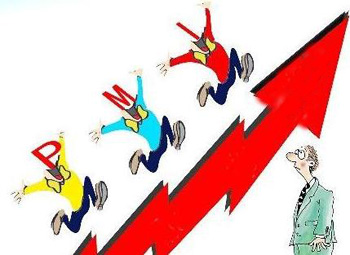Will China's economy keep growing or slow down?
- By Ye Tan
 0 Comment(s)
0 Comment(s) Print
Print E-mail Jiefang Daily, March 7, 2012
E-mail Jiefang Daily, March 7, 2012

China's Purchasing Managers' Index (PMI) rose 0.5 percentage points from the previous month to 51 percent in February, which boosts Chinese people’s confidence in the country's economy, according to statistics from the China Federation of Logistics and Purchasing (CFLP).
The country's PMI has been slightly over the critical point of 50 percent that demarcates expansion and contraction for three consecutive months. The PMI reading of 51 percent shows a slow expansion, lower than the historical average of 52.7 percent, which suggests that the foundation for the recovery of the country’s manufacturing economy is not solid enough. However, there is also good news. The five major PMI sub-indices, including the sub-indices of production, new orders, employment, and supplier deliveries, all rose, except the sub-index of raw material inventory.
Statistics from the CFLP show that major manufacturers are recovering due to an improved investment environment and loosened monetary policy.
Industries that are growing include traffic and transportation equipment manufacturing industry, general-purpose equipment manufacturing industry, electrical machine and equipment manufacturing industry, special equipment, instrument and meter manufacturing industry, communication equipment, computer and electronic equipment manufacturing industry as well as medicine production industry. However, situations of iron ore, cooper industry, shipping and oil industries are not optimistic. Except for the equipment manufacturing, situations of other raw materials and manufacturing industries are also not good. Therefore, the financial strain of China's large enterprises has eased. In the inter-bank lending market of Shanghai, both the short-term and long-term interest rates are at low levels and the measure of reducing deposit-reserve ratio has taken effect very quickly.
Comparatively, situations of China's small and medium-sized enterprises are much worse. According to the HSBC China Manufacturing Purchasing Managers Index issued on March 1, the HSBC China Manufacturing PMI of February was 49.6, up 0.8 percentage points compared to that of January but still lower than the expectation.
The newly-received order of the enterprises had decreased for four successive months, the newly-increased export volume had set the largest negative growth rate since June of 2011, and the domestic demand still had not improved much. Due to the weak growth, the enterprises have reduced the storage of raw materials and delayed the delivery time, leading to the second excessive inventory in the past 19 months.
Policy presetting and fine tuning, as well as increasing investment promote the slow recovery of China’s economy. Main possible risks lie in three aspects: real economy overcapacity, consumption declining and business cost rising. Of which, the overcapacity will reduce corporate profit, while consumption declining may put investment into a dominant position once again, and rising of raw material costs may lead to stagflation.
Good news is that market consumer confidence has been restored somewhat. Since Jan. 20, CSI Consumer Index (399932) has risen to 5,944 points from 5,100 points with an increased volume of transactions. Meanwhile, the property sector in stock market also makes a good turn.
Recovery in consumer confidence is as weak as that of real economy, which may get down again if real estate and household consumption turn to drop.
This article is edited and translated by People's Daily Online.






Go to Forum >>0 Comment(s)